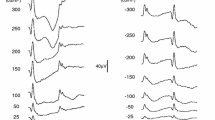Abstract
Purpose
To investigate the retinal responses generated by flash interactions in a recently introduced “global (full-screen) flash” stimulus paradigm to record the multifocal electroretinogram (mfERG).
Methods
Five normal individuals were studied with stimulation combining multifocal (pseudorandom) flashes with interleaved global (periodic, full-screen) flashes. The intensities of the two flashes were independently varied. Two distinct first-order response components were obtained: the mean response to the focal flashes (referred to as the direct response, DR) and the effect of the focal flash on the responses evoked by the global flash (the induced component, IC).
Results
Increasing the global flash luminance reduced DR amplitude and shortened DR implicit time. IC amplitude peaked with a moderate global flash (1.33–2.67 cd·s/m2). With a global flash of the right intensity, a weak focal flash could evoke a considerable IC even when the DR was barely detectable. Moderate global flashes maximized the IC, and its intersubject variability was reduced at lower focal flash luminances. IC topography had a large naso-temporal asymmetry.
Conclusions
While the DR is the average response generated by the local flashes regardless of the context of preceding and following flashes, the IC represents the difference in the global flash response in the presence and absence of the preceding focal flash. As the focal flashes were always preceded by the periodically occurring global flashes, the DR reflects the resulting adapted or desensitized state of the retinal patch. The pure, nonlinear IC is thought to reflect predominantly inner retinal function.







Similar content being viewed by others
References
Bearse MA, Shimada Y, Sutter EE (2000) Distribution of oscillatory components in the central retina. Doc Ophthalmol 100:185–205
Bearse MA, Sutter EE, Sim D, Stamper R (1996) Glaucomatous dysfunction revealed in higher order components of the electroretinogram. In: Vision science and its applications, 1996 OSA technical digest series, vol 1. Optical Society of America, Washington, DC, pp 104–107
Bornschein H, Gunter R (1964) The double-flash ERG in retinal ischemia. Vision Res 4:423–432
Burian HM, Spivey BE (1959) The effect of twin flashes and of repetitive light stimuli on the human electroretinogram. Am J Ophthalmol 48:274–286
Fortune B, Bearse MA, Cioffi GA, Johnson CA (2002) Selective loss of an oscillatory component from temporal retinal multifocal ERG responses in glaucoma. Invest Ophthalmol Vis Sci 43:2638–2647
Gliem H, Möller DE, Kietzmann G (1973) Das Doppelblitz-ERG bei der diabetischen Retinopathie. Acta Ophthalmol 51:85–94
Kondo M, Miyake Y, Kondo N, Tanikawa A, Suzuki S, Horiguchi M, Terasaki H (2001) Multifocal ERG findings in complete type congenital stationary night blindness. Invest Ophthalmol Vis Sci 42:1342–1348
Hasegawa S, Ohshima A, Hayakawa Y, Takagi M, Abe H (2001) Multifocal electroretinogram in patients with branch retinal artery occlusion. Invest Ophthalmol Vis Sci 42:298–304
Hood DC, Greenstein VC, Holopigian K, Bauer R, Firoz B, Liebmann JM, Odel JG, Ritch R (2000) An attempt to detect glaucomatous damage to the inner retina with the multifocal ERG. Invest Ophthalmol Vis Sci 41:1570–1579
Hood DC, Seiple W, Holopigian K, Greenstein V (1997) A comparison of the components of the multi-focal and full-field ERGs. Vis Neurosci 14:533–544
Horiguchi M, Suzuki S, Kondo M, Tanikawa A, Miyake Y (1998) Effect of glutamate analogues and inhibitory neurotransmitters on the electroretinograms elicited by random sequence stimuli in rabbits. Invest Ophthalmol Vis Sci 39:2171–2176
Mahnecke A (1957) Electroretinography with double flashes. Acta Ophthalmol 35:131–141
Nagasaka K, Horiguchi M, Shimada Y, Yuzawa M (2003) Multifocal electroretinograms in cases of central areolar choroidal dystrophy. Invest Ophthalmol Vis Sci 44:1673–1679
Palmowski AM, Allgayer R, Heinemann-Vernaleken B, Ruprecht KW (2002) Multifocal electroretinogram with a multiflash stimulation technique in open-angle glaucoma. Ophthalmic Res 34:83–89
Palmowski AM, Sutter EE, Bearse MA, Fung W (1997) Mapping of retinal function in diabetic retinopathy using the multifocal electroretinogram. Invest Ophthalmol Vis Sci 38:2586–2596
Penrose PJ, Tzekov RT, Sutter EE, Fu AD, Allen AW Jr, Fung WE, Oxford KW (2003) Multifocal electroretinography evaluation for early detection of retinal dysfunction in patients taking hydroxychloroquine. Retina 23:503–512
Shimada Y, Li Y, Sutter EE, Bearse MA, Fung W (2001) Assessment of early retinal changes in diabetes using a new multifocal ERG protocol. Br J Ophthalmol 85:414–419
Sutter EE (2000) The interpretation of multifocal binary kernels. Doc Ophthalmol 100:49–75
Sutter EE (2001) Imaging visual function with the multifocal m-sequence technique. Vision Res 41:1241–1255
Sutter EE, Bearse MA (1998) The retinal topography of local and lateral gain control mechanisms. In: Vision science and its applications. 1998 OSA technical digest series, vol 1. Optical Society of America, Washington, DC, pp 20–23
Sutter EE, Bearse MA (1999) The optic nerve head component of the human ERG. Vision Res 39:419–436
Sutter EE, Shimada Y, Li Y, Bearse MA (1999) Mapping inner retinal function through enhancement of adaptive components in the M-ERG. In: Vision science and its applications. Technical digest series. Optical Society of America, Washington, DC, pp 52–55
Sutter EE, Tran D (1992) The field topography of ERG components in man. I. The photopic luminance response. Vision Res 32:433–446
Acknowledgements
The authors thank Alex Lomakin for the software development and Yong Li for recording assistance. Grant support: Grant No. 5-1998-6 from Juvenile Diabetes Foundation (New York, NY), grant No. EY06861 from National Institutes of Health (NIH) (Bethesda, MD).
Author information
Authors and Affiliations
Corresponding author
Rights and permissions
About this article
Cite this article
Shimada, Y., Bearse, M.A. & Sutter, E.E. Multifocal electroretinograms combined with periodic flashes: direct responses and induced components. Graefe's Arch Clin Exp Ophthalmol 243, 132–141 (2005). https://doi.org/10.1007/s00417-004-1072-y
Received:
Revised:
Accepted:
Published:
Issue Date:
DOI: https://doi.org/10.1007/s00417-004-1072-y




